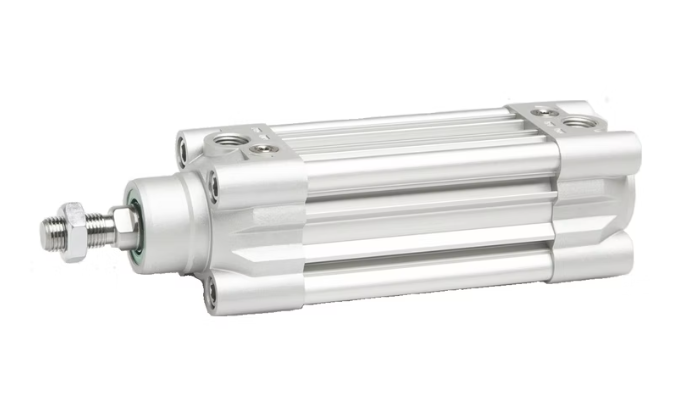
ISO pneumatic cylinders allow you to get the exact cylinder your company requires in the instances of both a replacement or a new design-build project. Having these interchangeable cylinders available at your manufacturer or distributor keeps your production on schedule. This is why W.C. Branham has expanded our product line of actuators to include ISO-compliant pneumatic cylinders.
ISO cylinders, like NFPA cylinders, can be single- or double-rodded and can accommodate magnetic sensors if needed. Replacing one ISO cylinder with another of similar specification ensures you will get a perfect dimensional fit–critical for consistent, reliable performance whatever your application.
What Is ISO?
The International Organization for Standardization (ISO) is an independent, international entity that establishes quality and safety standards used by manufacturers worldwide. The point is to ensure consistent, reliable production by helping companies work more accurately and efficiently. There are ISO standards that apply to specific products, services, and overall systems.
An ISO pneumatic cylinder is one that meets ISO specifications and standards based on the type of actuator.
- ISO 15552 Standard Cylinder
- ISO 21287 Compact Cylinder
- ISO 6432 Round Body Cylinder
Pneumatic cylinders are widely used in industrial settings because they are the best choice to perform many types of tasks necessary for food and beverage processing and packaging, printing, material handling, and more.
Quality Considerations for ISO Cylinders
No one wants to overpay for industrial components. But a cylinder that costs less upfront may not give you the long, consistent service life you expect and need. If it doesn’t, you’ll wind up paying more in the long run–so price should not be your only consideration.
Aside from cost, the ISO designation alone doesn’t guarantee you’re getting the best product. Cylinders are made up of multiple components. Here’s what you need to know to determine the quality of the cylinders you’re considering, which sometimes includes what’s inside. The information is not always available in the brand’s specs. If it’s not, be prepared with these things you should ask the manufacturer about.
1. The type of seals
What the material seals are made of determines how well they do their job and how long they last–two factors that are mission-critical for any equipment that uses actuators. In industrial settings, imperfect seals can allow contaminants to infiltrate the cylinder and/or allow lubricants to leak, potentially endangering both the equipment and the products being made. Look for seals made by a well-established company that uses time-proven materials for their seals.
2. The structure of the caps
If the caps aren’t securely fastened, repeated operating cycles and vibration can weaken the attachment causing performance problems. It’s essential that caps have a solid structure, especially around the screw holes, with reinforcing ribbing or something similar that ensures the caps remain tightly secured to the cylinder under duress.
3. Piston material
Pistons take the brunt of every stroke. The stronger and more durable the material, the longer the piston will last. Some ISO actuators use pistons made of a plastic compound, which is less expensive but also prone to breakage or quicker wear. Pistons made of aluminum are tougher and more durable.
4. Cushioning pin material
Here, too, material directly affects longevity and overall cost-effectiveness. Cushioning pins absorb force so they have to be durable. While some ISO cylinders use cushioning pins made of nickel-plated aluminum or another material, the strongest material is nickel-plated steel. In harsh environments where corrosion resistance is also an important factor, only nickel-plated steel or stainless steel are advisable.
Who Needs an ISO Pneumatic Cylinder?
As we all know, metric dimensions are not the same as imperial standard units we predominantly use in American manufacturing and industrial design. But not all equipment used here in the States is made here–sometimes machinery is imported from Europe or other regions where the metric system prevails. Since that equipment is designed to conform to European metric standards, it has metric components. That doesn’t matter until you need replacement parts and you realize standard US-made pneumatic cylinders may not exactly be the same.
In the past, you could order those parts from a European supplier. But the major disruption of the global supply chain has made it extremely difficult to get those vital replacement parts, certainly not in a timely manner. American manufacturing and industrial facilities can’t afford to sit around idle waiting for parts to arrive.
Some American equipment manufacturers also sell their products outside the US, in countries where metric standards are required. Or, they would like to do so to expand their business. These companies also need ISO pneumatic cylinders but face the same supply challenges.
Our W.C. Branham-Artec Partnership Relieves the Pressure
Artec manufactures pneumatic cylinders that meet all three ISO standards in addition to stainless steel options. These products are interchangeable with other ISO cylinders, so now customers in the US and Canada who are looking for replacement parts can simply call us here at W.C. Branham to get what they need.
Readily available components mean companies can bypass downtime to stay on track with production. An expanded catalog of pneumatic cylinder options will help businesses in future equipment design and application solutions. W.C. Branham is excited about our partnership with Artec because it enables us to help even more customers solve their equipment design and operational challenges.


